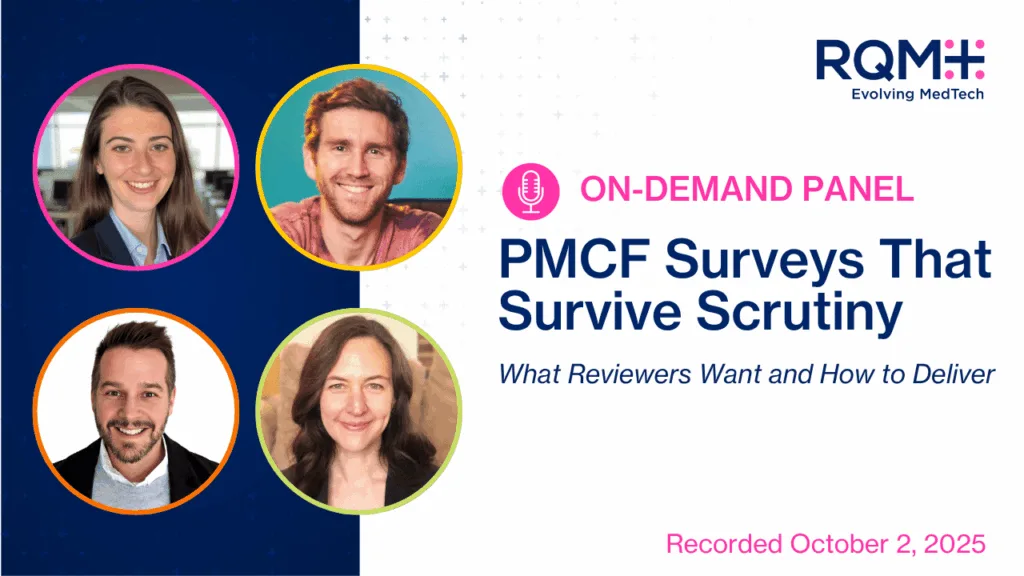Under the EU Medical Device Regulation (MDR), post-market clinical follow-up (PMCF) plays a key part in maintaining evidence of safety and performance after a device is placed on the market. For high-risk devices (such as Class III implants or novel technologies) manufacturers must continuously collect clinical data to confirm that benefits outweigh risks. One increasingly common approach is the PMCF survey, which gathers real-world evidence through structured questionnaires distributed to clinicians or patients.
Yet, the question remains: Are high-quality PMCF surveys alone sufficient for high-risk devices? The MDR has raised the bar for clinical evidence, eliminating grandfathering of legacy devices and placing greater emphasis on real-world performance. While PMCF surveys are efficient and scalable for high-risk devices, their adequacy depends on a robust design and sophisticated strategy in the context of a tailored ensemble of evidence.
Defining “High-Quality” PMCF Surveys
Not all surveys are created equal. According to MDCG 2020-6 Appendix III, post-market data sources are ranked by evidentiary strength. High-quality PMCF user surveys are considered Level 4 evidence (a meaningful source of clinical data) while basic “user feedback” or satisfaction questionnaires fall to Level 8 evidence.
A high-quality PMCF survey typically features:
- A prospective, pre-defined design aligned with clinical endpoints.
- Targeted respondents (qualified clinicians or end-users) with case-level data rather than general opinions.
- Scientific validity, including clear objectives, appropriate sampling, and statistical planning.
- Bias minimization, achieved through structured data collection and documentation.
- Collection of anonymous responses without protected, personally-identifying health information.
When properly designed, high-quality surveys approach the rigor of observational studies. For instance, collecting physician-reported outcomes per patient case reduces recall bias and improves traceability, which are key factors regulators assess when evaluating the level of PMCF evidence.
Regulatory Expectations for High-Risk Devices
For Class III and IIb high-risk devices, the MDR mandates a high level of clinical evidence. Article 61(1) requires manufacturers to justify that their clinical evidence is appropriate given the device’s risk and novelty on the market.
Regulators and Notified Bodies generally expect robust clinical investigations (Level 1–2 evidence) for novel high-risk devices, unless manufacturers provide sound justification for alternative approaches. However, for legacy devices (i.e., those with extensive historical use but limited pre-market data) Level 4 high-quality PMCF surveys bridge the evidence gap when complemented by existing data sources.
Still, Notified Bodies will encourage or require additional PMCF activities, such as registries or targeted observational trials, when the device introduces new materials, indications, or risk factors that can impact patient outcomes clinically. High-quality surveys alone are accepted only if they demonstrate relevant safety and performance outcomes with sufficient depth in the context of the manufacturer’s documented knowledge of the device.
Advantages of High-Quality PMCF Surveys
When executed effectively, high-quality PMCF surveys offer multiple advantages:
- Efficient and scalable: enable manufacturers to gather data across diverse regions and clinical settings faster and at lower cost than clinical trials.
- Broader patient reach: sample large populations, revealing long-term or rare complications not captured pre-market.
- Cost-effective: especially for startups, provide meaningful evidence without the financial burden of a full post-market study.
- Regulatory acceptance of real-world data: regulators increasingly find value in real-world evidence (RWE). A high-quality PMCF survey complements clinical trials by filling data gaps such as device use in specific subgroups or patient-reported outcomes over time.
For example, a novel cardiovascular implant with a prior pre-market study could use a high-quality PMCF survey to continually gather longitudinal safety and usability data from several countries, thereby strengthening its evidence base and supporting ongoing conformity under MDR.
Limitations and When High-Quality PMCF Surveys May Not Suffice
Despite their benefits, even high-quality PMCF surveys have inherent limitations. Even the best-designed surveys are observational and non-interventional, and therefore vulnerable to reporting and sampling bias. For new or high-risk implants, regulators often expect PMCF clinical studies that can capture hard endpoints including survival, revision rates, or verified adverse event frequencies in monitored settings.
Key limitations of high-quality PMCF surveys include:
- Potential bias: respondent recall or sampling bias may distort findings.
- Sample size constraints: adequate statistical power is critical—detecting rare events may require large datasets.
- Data depth: surveys rarely provide comprehensive outcomes data or comparator arms typical of clinical studies.
Under EU MDR, manufacturers justify why their chosen PMCF methods, whether surveys, registries, or trials, are adequate to maintain conformity. For novel or high-risk devices, Notified Bodies may determine that surveys alone do not provide sufficient clinical evidence, prompting requests for additional PMCF studies.
Typical cases where surveys alone are insufficient include:
- Brand-new Class III implants without long-term safety data.
- Devices that use new technologies or materials with limited clinical history.
- Devices intended to sustain life, where the consequences of failure are severe.
In these cases, regulators generally expect high-quality PMCF surveys to complement an existing evidence framework that includes registries and clinical trials.
Recent Trends and Notified Body Feedback
Since EU MDR enforcement, high-quality PMCF surveys have surged in popularity as a preferred tool for collecting real-world evidence. However, Notified Bodies scrutinize methodologies closely—only decision-grade high-quality PMCF surveys that demonstrate statistical and scientific rigor are accepted.
RQM+ and other regulatory experts emphasize several success factors:
- Define objectives and endpoints clearly in the PMCF plan.
- Ensure traceability and transparency—document design, sampling, and analysis logic in detail.
- Follow MDCG guidance for PMCF planning and execution.
- Justify the evidence level for the device risk per EU MDR Article 61.
Panel discussions hosted by RQM+ highlight that regulators value high-quality PMCF surveys when they are methodologically sound. Poorly designed surveys, such as those with vague endpoints, low response rates, or anecdotal feedback, may be rejected during conformity assessments.
Closing Thoughts on High-Quality PMCF Surveys
So, are high-quality PMCF surveys enough for high-risk devices? The answer is: yes, but only with strong justification in the context of existing evidence.
High-quality PMCF surveys, if designed with robust methods, provide meaningful real-world data and meet MDR evidence requirements for some high-risk or legacy devices. However, they are not sufficient on their own for novel, high-risk, or life-sustaining technologies.
Manufacturers should integrate PMCF surveys as part of a comprehensive evidence strategy to complement post-market surveillance, registries, follow-up studies, or literature reviews. When surveys are used, ensure they are scientifically rigorous: clinically focused, designed for target users, and statistically powered. Ultimately, regulators welcome high-quality PMCF surveys that match the device’s risk classification, intended purpose, and can deliver the clinical insights necessary to demonstrate continued safety and performance. For some high-risk devices, a high-quality PMCF survey can indeed be enough.
In case you missed it, watch the on-demand panel discussion “PMCF Surveys That Survive Scrutiny: What Reviewers Want and How to Deliver”.

